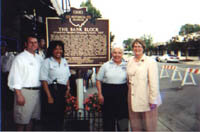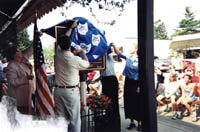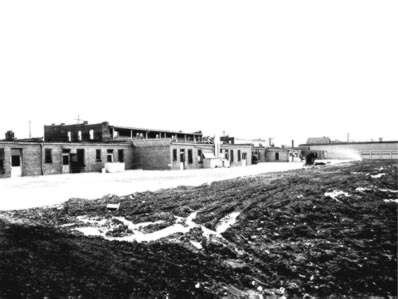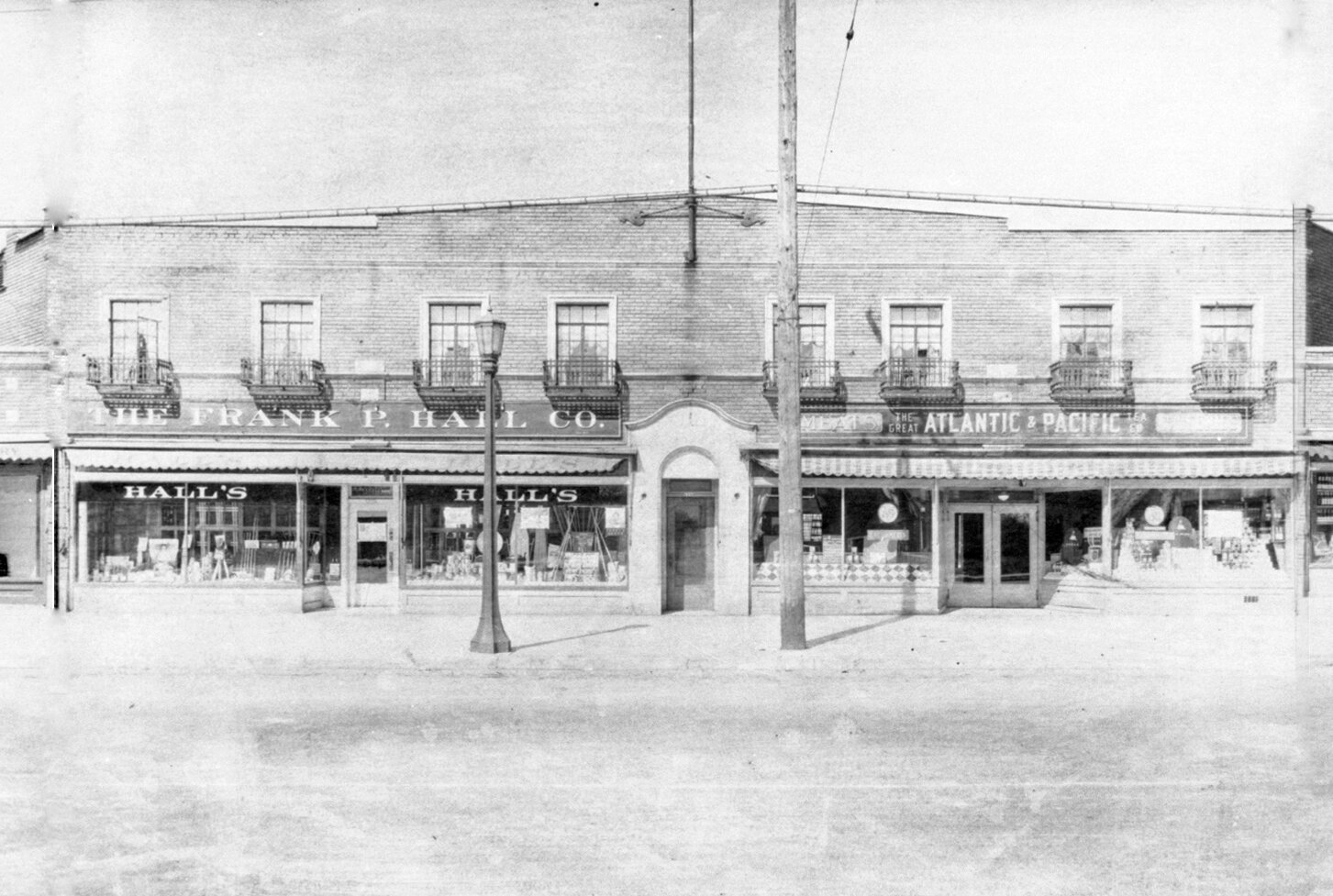
Grandview Heights Bank Block
An Historic Development
One of the most prominent business centers in Grandview Heights is the Grandview Bank Block. Originally called the Grandview Avenue Shopping Center, it was built in 1927 by pioneering retail developer Don Monroe Casto Sr. of Columbus. According to an interview of Casto in a recent WOSU-TV special, the concept of the shopping center grew out of a desire to provide shopping resources in proximity to the rapidly expanding residential areas in Upper Arlington and Grandview.
The development was innovative, responding to a new era that saw the increase in use and importance of the automobile. The mindset of developers at the time was to build shopping venues adjacent to the street, separated only by a sidewalk. In order to accommodate the automobile, they added on-street parking. According to Casto, this was an insufficient design in that it wouldn’t provide enough parking for the number of shoppers that he envisioned. So the new shopping center was designed with 30 shops and incorporated parking spaces for up to 400 cars at the rear of what was to called the nation’s first “strip center”. It was also the first regional shopping center and it was unique in having multiple national grocery stores in it (Kroger, Piggly Wiggly, and the A&P Tea Company.)
The current designation as the Bank Block was due to the fact that its anchor tenant was the First Citizens Trust, later known as the Ohio National Bank. The 1928 opening received national attention, and included a special appearance by the child actors from the “Our Gang” films (Alfalfa, Spanky, etc). It enjoyed a great deal of popularity in its early years, attracting Columbus visitors in addition to the strong local following. In 1932, a new owner purchased the property from Casto. After the owner’s death, it went into a trust, which was later transferred to the Cadiz Methodist Church. Primarily because of neglect of the non-resident owners, the block fell into disrepair.
By 1976 only two retail stores remained, a hardware store and an office supply store, and much of the space was used as storage. Many conversations and discussions were had about the eyesore on Grandview Avenue, and city officials even considered tearing the block down. Local developers and property managers, the Wagenbrenner brothers, saw the possibilities of a revival of the space, and a 1976 Columbus Dispatch headline read “Wagenbrenner Brothers plan to spend nearly $750,000 acquiring and renovating Grandview Heights’ aging "Bank Block” and plan to turn it into a bazaar-type center” that would include restaurants and specialty stores. A crucial tenant was found to provide an anchor to the proposed development, and Chef Hubert Seifert opened the Gourmet Market, which would later become Spagio. Over the next decade expansion was slow, but the Bank Block eventually returned to its original vibrance.
One of the country's first shopping centers, and the first strip shopping center in America that integrated parking into the design, the Bank Block was built in 1927 by Don Casto, Sr. It is currently owned by Wagenbrenner and Co. and is on the National Register of Historic Places.
The Bank Block was accepted for listing on the National Register of Historic Places for its 70th anniversary in 1998, and with the help of the Historical Society was the recipient of an Ohio Historical Marker in 2000. The inscription on the marker reads:
Built by pioneering retail developer Don Monroe Casto Sr., the Bank Block was dedicated in 1928. Considered one of the earliest regional shopping centers in the United States, it innovatively featured 350 free parking spaces-complete with uniformed attendant-to accommodate the rapidly growing numbers of automobile-owning suburbanites. The Bank Block's first tenants included several competing national grocers (Kroger, A&P, and Piggly Wiggly), the First Citizens Trust (later Ohio National Bank), a stationer, barber shop, and pharmacy. It remains the nucleus of Grandview's commercial district. Casto, once described as "the man who changed the shopping habits of the free world," also built the Town and Country Shopping Center in Whitehall and was a dominant figure in retail commercial development in the Midwest for much of the 20th century. Erected in 2000 wiht support of the Ohio Bicentennial Commission, The Longaberger Company, The Grandview Heights-Marble Cliff Historical Society, and The Ohio Historical Society. (Marker Number 34-25)
The installation of the marker was celebrated with a ceremony on June 14, 2001. Historical Society Board President Tray Liberatore was the host, and guests included members of the Bicentennial Commission, Rep. Geoff Smith, Sen. Priscilla Mead, Don Casto, Mike Waggenbrenner, and members of the Grandview Heights City Council. The Boy Scouts from Troop 73 in Grandview presented the colors, and Board Member Wayne Carlson read a proclamation from Grandview Mayor Colleen Sexton, who was not able to attend. Spagio's sponsored a short reception after the unveiling.
Ohio Historical Marker: The Grandview Heights Bank Block
The GH/MCHS is proud that the Bank Block was awarded an Ohio Historical Marker (Marker Number 34-25). These markers, a small part of the Ohio Bicentennial celebration, are awarded to only those sites which have played a major role of importance in Ohio history. Each marker is hand-crafted and contain text describing the significance of the site.
The following images were taken at the installation ceremony on June 14, 2001.
Rep. Geoff Smith, Carmelita Boyer, Maureen Damiani, Sen. Priscilla Mead
The marker is unveiled by Carmelita Boyer, Central Ohio Regional Coordinator of the Bicentennial Commission and Phil Ross from the Ohio Historical Society
Grandview City Council Members- Maureen Damiani, David Jackson, Kelly Finan, Keith DuFrane, Ray DeGraw
Grandview Director of Services Sam Troiano, who was instrumental in the installation of the marker, and Council memeber Maureen Damiani
Sen. Priscilla Mead
Boy Scout Troop 73, from Boulevard Presbyterian Church in Grandview Heights
Historical Society President Tracy Liberatore (Background L-R: Sen. Priscilla Mead, Mike Waggenbrenner, and Don Casto)
Councilman David Jackson and GH/MCHS President Tracy Liberatore
Betty Salzgaber and GH/MCHS President Tracy Liberatore
Unveiling of the Marker by Phil Ross and Carmelita Boyer
Unveiling of the Marker
Don M. Casto
Kroger Grocery and Baking Co. and B&B Stationery (including B&B Books and Office Supply, and Flander's Jewelers)
Hall's Hardware and A&P (Atlantic and Pacific Tea Co.) Grocery
C.B. Grote, Piggly-Wiggly, and The Bobbie Barber Shoppe
Main Section - Piggly Wiggly and Grandview Market Food Shoppe
Citizens Trust, Young's Bakery, and The Davis Store
The Ice Cream Store
Fenton's Cleaners, B&B's Circulating Library, and Frank P. Hall Co.
Grandview Market Food Shoppe and Hamill's Pharmacy
Panorama of the Bank Block circa 1929 (click for a larger version)

























